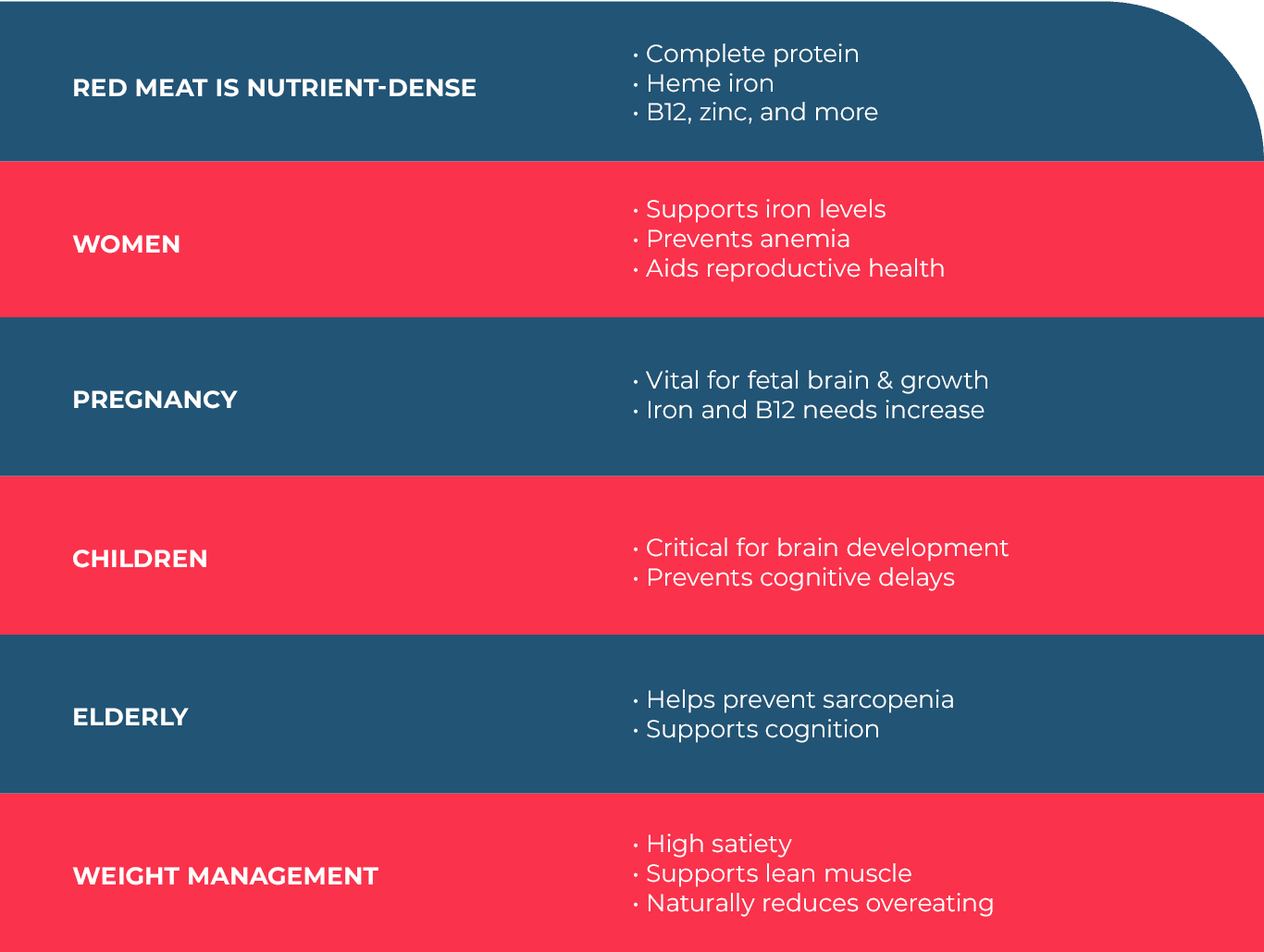Why Meat Matters—Especially for Women, Pregnant Women, Children, and the Elderly By Diana Rodgers, RD
As conversations around food systems and sustainability intensify, so too does the push toward plant-based diets. While I support conscious, ethical eating and a sustainable approach to food production, it’s critical that we don’t throw the baby out with the bathwater when it comes to nutrition—especially for those with the highest nutrient needs.
Women, pregnant women, children, and the elderly are particularly vulnerable to nutrient deficiencies. In the rush to demonize red meat, we risk compromising the health of those who need its nutrient density the most. That’s why I co-authored the recent article in Frontiers in Nutrition titled “Considering the Nutritional Benefits and Health Implications of Red Meat in the Era of Meatless Initiatives.” The paper highlights the essential role red meat plays in human health and how meatless messaging often ignores these critical realities.
Let’s take a deeper look at why red meat remains a vital, irreplaceable part of the diet— especially for women across life stages, young children, older adults, and even those working toward weight loss goals.
Meat: The Ultimate Nutrient-Dense Food
Meat, especially red meat, is one of the most nutrient-dense foods on the planet. It provides:
- Complete protein with all essential amino acids in highly bioavailable form
- Heme iron, which is far more absorbable than non-heme iron from plant sources
- Vitamin B12, found naturally only in animal products, critical for neurological and
cognitive health - Zinc, essential for immune function and DNA synthesis
- Fat-soluble vitamins like A, D, E, and K2, which are difficult to obtain in meaningful
amounts from plants - Other critical B vitamins like niacin, riboflavin, and B6
Many plant-based substitutes simply cannot match this unique package. Fortification and supplementation attempt to mimic what meat delivers naturally, but with less efficiency and, often, greater environmental processing and cost.
Why Women Need Red Meat
Women, especially those of reproductive age, face increased nutritional demands. Monthly blood loss during menstruation raises the risk of iron deficiency anemia. And while plant-based foods like spinach contain iron, it’s the non-heme form—poorly absorbed and often inhibited by compounds like phytates and oxalates found in those same foods.
Red meat contains heme iron, which is absorbed at a rate of 15–35%, compared to just 2–20% from non-heme iron, found in plant-based sources. That difference can mean the difference between thriving and dragging through the day with fatigue, headaches, or brain fog—classic symptoms of low iron.
Vitamin B12 is another concern. It’s crucial for brain health, red blood cell formation, and energy metabolism. Deficiency can mimic dementia and cause irreversible nerve damage if left untreated. Only animal-sourced foods provide it naturally. While supplements exist, they don’t always absorb well, especially in people with digestive issues or certain genetic conditions.
The Unique Needs of Pregnant Women
Pregnancy is a time of massive physiological change. Blood volume increases by nearly 50%, driving up the demand for iron, folate, and B12. In our Frontiers paper, we pointed out that up to 50% of pregnant women in middle and high-income countries are anemic, primarily due to iron deficiency.
The implications go beyond the mother’s health. Iron deficiency during pregnancy is linked to premature birth, low birth weight, and impaired cognitive development in infants. Once again, red meat is the most effective dietary source of heme iron and B12—nutrients needed to build new red blood cells, support the placenta, and nourish the growing fetus.
Pregnancy is not the time for restrictive eating. It’s a time for nutrient-dense, whole foods, and red meat delivers those essentials in a form the body can readily use.
Children: Growing Brains and Bodies Need Meat
Early childhood is a period of rapid brain and body development. Protein, iron, zinc, and B12 are foundational nutrients for this process, and red meat provides all of them.
Iron deficiency in toddlers is associated with delays in cognitive development, learning difficulties, and behavior issues. And while cereal companies love to advertise “fortified with iron,” this added non-heme iron isn’t nearly as effective or safe as heme iron from red meat. Excessive non-heme iron can even promote oxidative stress in the gut.
Zinc is another essential mineral for growth, immunity, and wound healing. Red meat is among the best sources of bioavailable zinc. And let’s not forget B12 again, which is critical for neurological development, especially in those early years.
What’s especially concerning is that meatless school lunch initiatives and “plant-forward” policies are being implemented without fully considering these facts. In our Frontiers paper, we call for nutritional equity—not just environmentally motivated policy—that protects the health of children above all.
Older Adults: Preventing Frailty and Cognitive Decline
As people age, they face increasing risk of sarcopenia—the gradual loss of muscle mass and strength. This loss contributes to falls, fractures, hospitalizations, and reduced quality of life.
High-quality protein is the single most important dietary factor to prevent and slow sarcopenia. Red meat not only supplies this protein, but also the leucine and other amino acids needed to trigger muscle protein synthesis. Plant-based proteins, by comparison, are incomplete and often require strategic combinations to come close to the amino acid profile of meat.
Additionally, older adults have reduced absorption of B12 due to changes in stomach acid and digestive efficiency. Since B12 deficiency can cause memory loss and mimic dementia, relying solely on supplements isn’t enough. Regular intake of red meat ensures a steady supply of B12 in its natural, active form.
And let’s not overlook iron, which remains important in older age, especially in people with chronic illnesses or those taking medications that affect absorption.
Red Meat and Weight Management: The Satiety Factor
Another overlooked benefit of red meat—especially lean cuts—is its high satiety value. Protein is the most satiating macronutrient, meaning it helps people feel fuller longer, naturally reducing overall calorie intake without the need for restrictive dieting.
Lean red meat contains 20–25 grams of high-quality protein per 100 grams, making it an excellent choice for those trying to lose weight or maintain a healthy body composition. Unlike many processed plant-based products, which often rely on refined oils, additives, or fillers to mimic meat, a lean steak or ground beef patty offers real food, real protein, and real satisfaction.
ncluding lean red meat in meals can help stabilize blood sugar, reduce cravings, and prevent overeating later in the day—all without relying on ultra-processed diet foods. In the weight-loss world, satiety is a secret weapon, and meat delivers it naturally.

Beyond Nutrients: A Call for Common Sense
In our Frontiers article, we highlight the growing pressure on institutions, food policy, and consumers to adopt meatless diets in the name of health and sustainability. But these narratives often ignore science and dismiss the reality that meat is not interchangeable with lentils or tofu— not for pregnant moms, growing kids, aging parents, or those trying to improve body composition.
Instead of pushing meatless ideologies, I’ve been encouraging policymakers to look at the science of nutrition, while also encouraging the meat industry to improve its practices. We should all consider how red meat can be integrated into balanced diets that reflect the unique needs of each stage of life.
Red meat has been an essential part of the human diet for millennia. It built our brains, supported reproduction, and carried us through the life cycle. To remove or vilify it—especially for those most in need—is not just nutritionally irresponsible. It’s morally questionable.
The Bottom Line
Red meat is not the enemy. For women, pregnant mothers, children, the elderly, and even those aiming to lose weight, it is a nutritional ally—providing critical, hard-to-replace nutrients in forms the body can actually use.
We can and should care about the sustainable and ethical food systems and there are improvements the meat industry can make, but human health should not be compromised. Let’s shift the conversation toward food systems that support both planetary and personal well-being— and keep red meat on the plate, where it belongs.





